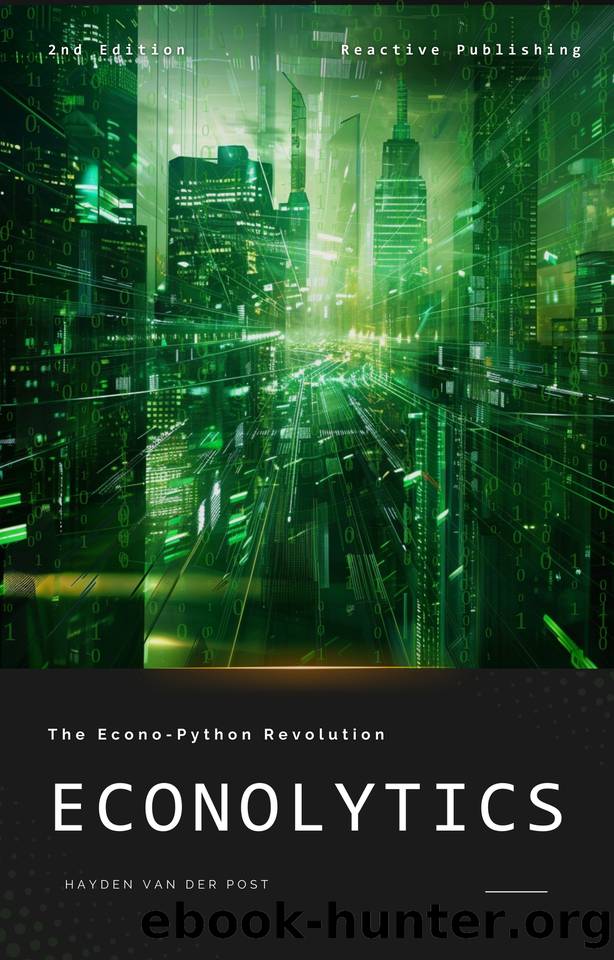Econolytics: The Econo-python Revolution: A Crash Course for Python Programming in Economics by Bisette Vincent & Strauss Johann & Van Der Post Hayden

Author:Bisette, Vincent & Strauss, Johann & Van Der Post, Hayden
Language: eng
Format: epub
Publisher: Reactive Publishing
Published: 2024-02-18T00:00:00+00:00
Chapter 7: Machine Learning and Artificial Intelligence in Economics
The frontier of economics is rapidly evolving, heralding a new epoch where machine learning and artificial intelligence (AI) are not just auxiliary tools but central to the discipline's future. This chapter embarks on an exploration of this transformative shift, delving into the intricacies of how machine learning and AI are revolutionizing economic analysis, forecasting, and policy-making.
Supervised vs. Unsupervised Learning: A Primer
In machine learning lies the distinction between supervised and unsupervised learning. Supervised learning, akin to learning with a guide, involves training a model on a labeled dataset, where the outcome of interest is known. This technique is paramount in predictive modeling, allowing economists to forecast future trends based on historical data. Conversely, unsupervised learning, akin to exploration in an unknown territory, deals with unlabeled data. Economists leverage this to uncover hidden patterns and relationships in economic data, often leading to groundbreaking insights into market dynamics.
Empowering Economic Analysis with Key Algorithms
Machine learning is not a monolithic field but a tapestry of algorithms, each with its strengths. Decision trees and neural networks, for instance, have found profound applications in economic analysis. Decision trees, with their simple yet powerful structure, are invaluable for classification and regression tasks, enabling economists to dissect complex decision-making processes. Neural networks, inspired by the human brain's architecture, excel at capturing nonlinear relationships in data, opening new avenues for understanding economic phenomena.
Case Study: Predictive Modeling for Economic Indicators
To illustrate the power of machine learning in economics, consider the application of neural networks in forecasting Gross Domestic Product (GDP) growth. By training a neural network on a rich dataset encompassing various economic indicators, analysts can predict future GDP growth with remarkable accuracy. This model not only outperforms traditional econometric models but also adapts to new information, continuously refining its predictions.
Integrating AI for Market Segmentation Analysis
Beyond predictive modeling, AI's prowess in unsupervised learning shines in market segmentation analysis. By applying clustering algorithms to consumer data, economists can identify distinct market segments, tailoring marketing strategies to each segment's unique preferences and behaviors. This targeted approach enhances the efficiency of marketing campaigns, optimizing resource allocation.
Natural Language Processing: Sentiment Analysis in Financial Markets
The advent of natural language processing (NLP), a subset of AI, has transformed the analysis of financial markets. Sentiment analysis, which gauges the mood of market participants from textual data, offers invaluable insights into market trends. By analyzing news articles, social media posts, and financial reports, NLP models can predict stock price movements, providing traders with a competitive edge.
Ethical Considerations and Future Implications
As we embrace the capabilities of machine learning and AI in economics, we must also navigate the ethical landscape they present. Issues of bias, fairness, and transparency in AI models are paramount, requiring meticulous attention to ensure that the benefits of these technologies are equitably distributed. Moreover, the future of work in an increasingly automated economy poses significant challenges and opportunities for policymakers.
The integration of machine learning and AI into economics is not merely a trend but a fundamental shift in how we understand and interact with economic systems.
Download
This site does not store any files on its server. We only index and link to content provided by other sites. Please contact the content providers to delete copyright contents if any and email us, we'll remove relevant links or contents immediately.
Deep Learning with Python by François Chollet(14852)
The Mikado Method by Ola Ellnestam Daniel Brolund(12104)
Hello! Python by Anthony Briggs(12015)
OCA Java SE 8 Programmer I Certification Guide by Mala Gupta(11409)
Dependency Injection in .NET by Mark Seemann(11193)
A Developer's Guide to Building Resilient Cloud Applications with Azure by Hamida Rebai Trabelsi(10528)
Algorithms of the Intelligent Web by Haralambos Marmanis;Dmitry Babenko(10012)
The Well-Grounded Java Developer by Benjamin J. Evans Martijn Verburg(9638)
Grails in Action by Glen Smith Peter Ledbrook(9333)
Hit Refresh by Satya Nadella(9039)
Sass and Compass in Action by Wynn Netherland Nathan Weizenbaum Chris Eppstein Brandon Mathis(8935)
Secrets of the JavaScript Ninja by John Resig Bear Bibeault(8836)
The Kubernetes Operator Framework Book by Michael Dame(8473)
Test-Driven iOS Development with Swift 4 by Dominik Hauser(8381)
Exploring Deepfakes by Bryan Lyon and Matt Tora(8295)
Robo-Advisor with Python by Aki Ranin(8248)
Practical Computer Architecture with Python and ARM by Alan Clements(8223)
Implementing Enterprise Observability for Success by Manisha Agrawal and Karun Krishnannair(8193)
Building Low Latency Applications with C++ by Sourav Ghosh(8097)
